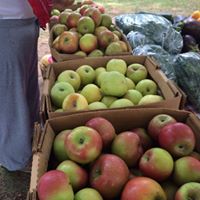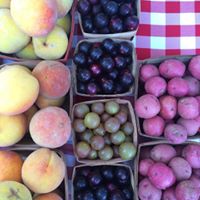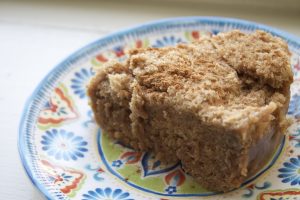Despite the generally warm and sunny weather Alabama gets from being in the South, is still lucky to receive all four seasons of the calendar  year, and with them, the specific blooming and harvesting patterns of various produce. Spring, the season of blooming buds and returning color to the Earth, is highlighted by the sprouting of fresh green vegetables like asparagus and crunchy romaine lettuce. As the transition to summer begins and the sun begins to rise higher for longer, the season of berries and melons takes place. Bright red, juicy, succulent strawberries pop from their vines, deep indigo orbs drop from the stems of the blueberry bushes, and snake green rinds are sliced open to reveal speckled, pale pink watermelon. When the leaves begin to drop and the Earth falls into a world of deep yellows, burgundies, and browns, gorging pumpkins, feathery fennel shoots, crunchy apples, and fluffy green kale are ready to be plucked for favorite autumnal dishes. When the calendar year begins to wind down, and the trees once again go bare in the crisp days of winter, an assortment of juicy citrus fruits can be harvested. Oranges, clementines, lemons, and nectarines are some of Alabama’s most tangy wintertime finds.
year, and with them, the specific blooming and harvesting patterns of various produce. Spring, the season of blooming buds and returning color to the Earth, is highlighted by the sprouting of fresh green vegetables like asparagus and crunchy romaine lettuce. As the transition to summer begins and the sun begins to rise higher for longer, the season of berries and melons takes place. Bright red, juicy, succulent strawberries pop from their vines, deep indigo orbs drop from the stems of the blueberry bushes, and snake green rinds are sliced open to reveal speckled, pale pink watermelon. When the leaves begin to drop and the Earth falls into a world of deep yellows, burgundies, and browns, gorging pumpkins, feathery fennel shoots, crunchy apples, and fluffy green kale are ready to be plucked for favorite autumnal dishes. When the calendar year begins to wind down, and the trees once again go bare in the crisp days of winter, an assortment of juicy citrus fruits can be harvested. Oranges, clementines, lemons, and nectarines are some of Alabama’s most tangy wintertime finds.
It’s often easy to identify which foods are in season based on the featured items served in popular chains, like Bread Co’s Summer Berry Smoothie or, one of my personal favorites, Starbucks’ Fall Pumpkin Spice Bread. Although it’s nice to indulge in these seasonal restaurant favorites, it’s important to eat more raw versions of the produce, too. Choosing to eat fresh, unprocessed fruits and vegetables during natural harvesting time has a variety of benefits.
Earth’s natural growing cycles often ensure food is at its best. The certain season in which specific fruits and vegetables grow have conditions that are ideal for reaching optimal ripeness. During peak season, produce often contains the largest amounts of vitamins, minerals, and antioxidants which provide a greater supply of nutrients to us when eaten.
Not only does eating fruits and vegetables in season provide more benefits to human health, it also helps improve the health of our planet. Most often, seasonal produce in grocery stores is coming from a place nearby because the foods are naturally abundant in that area. Since choosing seasonally usually means choosing foods grown locally, fewer resources are needed to harvest and transport foods from areas farther away. This has a tremendous effect on reducing the carbon footprint created from growing, harvesting, and transporting food.
As a college student, it may seem challenging to practice and reap the rewards of seasonal eating due to the restraints of the dining halls and the abundance of cheap chain restaurants like Chik-fil-A and Panda Express, but there are definitely a variety of ways to implement eating ripe fruits and vegetables into our daily diets. Researching the seasonality of different fruits and vegetables is an easy first step. From there, the seasonal eater should look to eat the current season’s foods being served in the dining halls. For example, this coming spring students can focus on the salad bars were the shoots of leafy greens are most likely to be locally produced and recently harvested.
We can also make a change by choosing to go grocery shopping at the local farmer’s markets rather than retail chains. Not only will you be getting some the freshest produce, you’ll also be directly contributing to the community’s local gardeners and farmers, which can help Tuscaloosa maintain a community-based selection of fruits and vegetables.
At UA, there are two farmer’s markets located within close proximity to the campus. The Tuscaloosa River Market, held along the Riverwalk, takes place in the spring every Saturday from 7 a.m. to 12 p.m. and is about a fifteen-minute stroll from most dorms.
Tuscaloosa River Market, held along the Riverwalk, takes place in the spring every Saturday from 7 a.m. to 12 p.m. and is about a fifteen-minute stroll from most dorms.
At the beginning of the Fall semester each year, students can also partake in theUniversity’s student-led farmer’s market, Homegrown Alabama, where an assortment of produce from late summer months and the beginni ngs of autumn are featured: tomatoes, berries, pumpkins, melons, and more.
ngs of autumn are featured: tomatoes, berries, pumpkins, melons, and more.
Whether from the dining hall or the farmer’s market, one truly cannot go wrong choosing fresh and choosing seasonal.
Homemade, Dorm-style, Vegan Pumpkin Spice Bread
Ingredients
- 1 box of Duncan Hine’s Pumpkin Spice Cake Mix
- 1 c almond milk
- 2 tbsp dairy-free butter, melted
- ½ c applesauce
- Dash of cinnamon for on top
Preparation
- Place all ingredients into a blender
- Blend until smooth
- Grease the inside of a large, covered, microwaveable bowl
- Pour cake batter into bowl
- Heat for 5 minutes
- Ensure cake is cooked thoroughly by using a toothpick test
- Flip cake onto flat surface and let cool for 10 minutes
- Cut into slices and enjoy!

